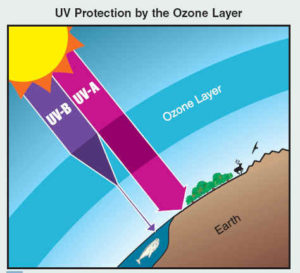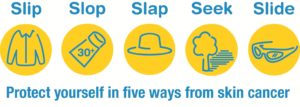As Independence Day celebrations and summer vacations approach, Hollis Cobb Associates stresses the importance of skin care when working and playing in the heat of the sun. Taking precautions against over exposure to the sun is vital for preventing sun damage and skin cancer.
Most Common Type of Cancer
According to physicians at John’s Hopkins Hospital, skin cancer is the most common type of cancer, accounting for nearly half of all cancer cases. The Skin Cancer Foundation defines the disease as the uncontrolled growth of abnormal skin cells caused when DNA damage to the skin cells triggers mutations that lead the cells to multiply rapidly and form malignant tumors.
Physicians at John’s Hopkins recommend staying out of the sun during the peak hours of 10am – 2pm when the sun’s rays are the strongest. In addition, water and sand reflect and intensify the sun’s rays; therefore relaxing on the beach or by the pool can be especially dangerous to unprotected skin. Individuals with thinning hair may not realize how easily they can develop skin cancer on the scalp. As important as it is to apply sunscreen to the body, it is equally important to remember to apply it to the scalp as well.
 Ultraviolet Rays and the UV Index
Ultraviolet Rays and the UV Index
Exposure to Ultraviolet rays from the sun and tanning beds are the number one causes of skin cancer, according to the American Cancer Society. Such exposure can cause sunburn, skin and eye damage and premature wrinkles ultimately leading to skin cancer. Sun damage is caused by both UVA and UVB rays from the sun according to the Centers for Disease Control and Prevention (CDC). UVA rays can reach deep into the human skin damaging connective tissue and the skin’s DNA. UVB rays are partially absorbed by the ozone layer of the Earth’s atmosphere, but still cause sun damage to the skin.
The CDC encourages people who spend time outdoors to check the UV index each day. The UV Index was developed by The National Weather Service and the Environmental Protection Agency, and predicts UV exposure on a scale of 1 – 15. A UV index of 3 or higher indicates sun protection is needed that day. In addition to causing sunburn, over exposure to UV rays can cause changes to skin texture as well as cataracts in the eyes.
Take Precautions to Protect Skin
The American Cancer Society recommends taking the following precautions to stay sun-safe:
- Wear a wide brimmed hat to protect as much of the skin as possible
- Wear sunglasses designed to block Ultraviolet light for eye protection
- Use a sunscreen that is 30 SPF or higher which filters out 97% of the sun’s UVB rays
- Look for sunscreens labeled “broad spectrum” which means they block both UVA and UVB rays.
- Water resistant sunscreen does not mean waterproof; therefore sunscreen should be reapplied every two hours
- Limit direct exposure to the sun during peak hours by staying in the shade as much as possible
- Avoid tanning beds and sunlamps which can cause long-term skin damage and contribute to skin cancer
What to Look for
Doctors at the Mayo Clinic state that, although skin cancer develops primarily in areas most exposed to the sun, it can also develop on the palms, soles of feet and underneath fingernails and toenails. Individuals with fair skin should be especially careful about overexposure to the sun; however those with darker skin complexions are not immune to skin cancer. Common signs of skin cancer include:
- A pearly or waxy-looking bump
- A flat flesh-colored or brown scar-like lesion
- A firm, red nodule
- A flat lesion with scaly surface
- A large brown spot with darker speckles
- A mole that changes size, color or bleeds
- A small lesion with an irregular border
Any changes in the skin or unusual growths warrant an immediate visit to the dermatologist.
Take the Time to Get Screened
Regular skin screenings performed by licensed dermatologists are crucial according to the National Foundation for Cancer Research. A dermatologist can assess a patient and recommend frequency of skin exams based on medical history and personal risk factors. Individuals with a family history of skin cancer should have a full-body exam on a yearly basis, and everyone should perform a self-exam each month to check for new moles or any changes in the skin. Approximately half of all skin cancers are self-detected according to researchers at the National Foundation for Cancer Research, and the sooner treatment starts, the better the chances for a complete recovery.


